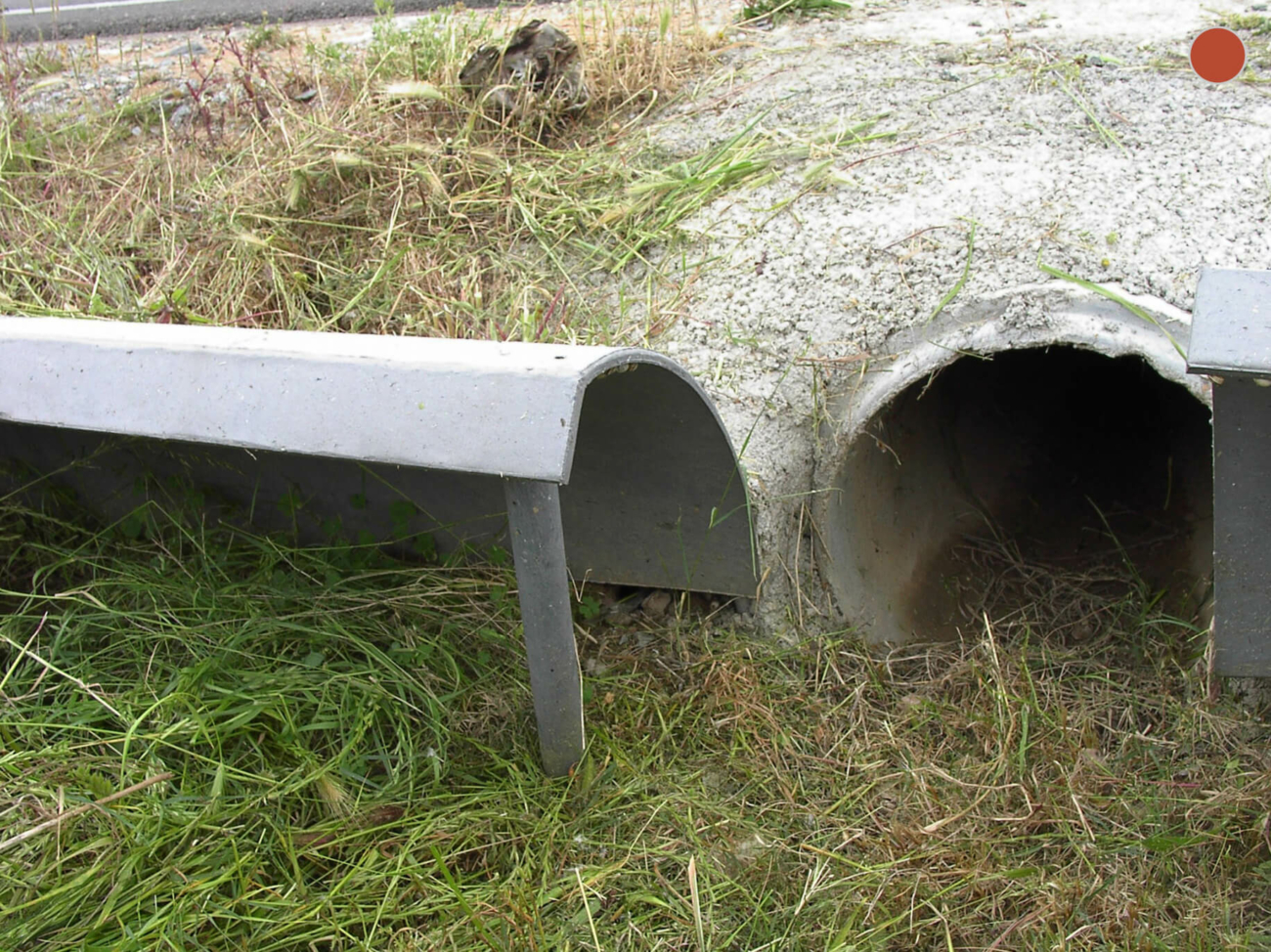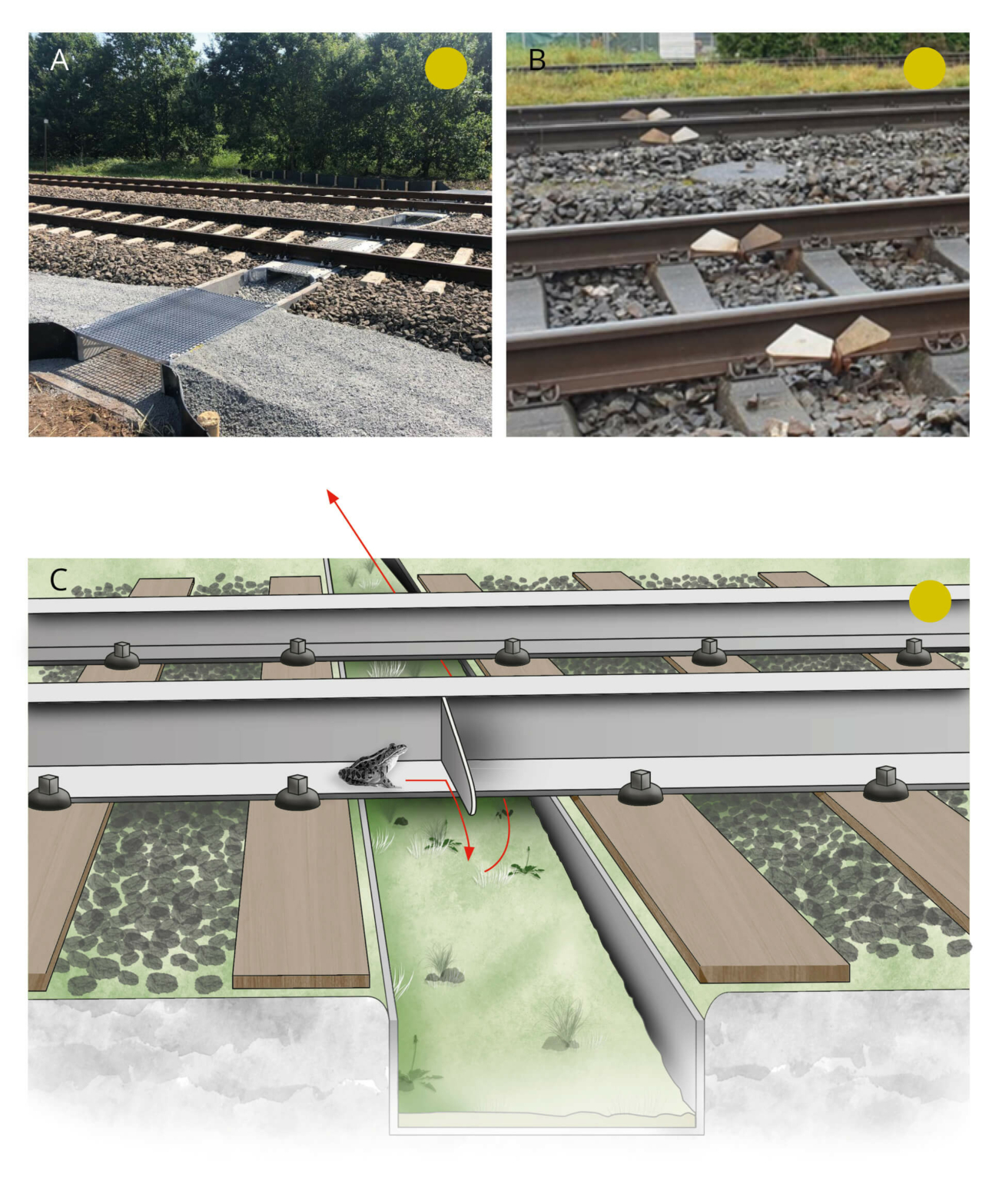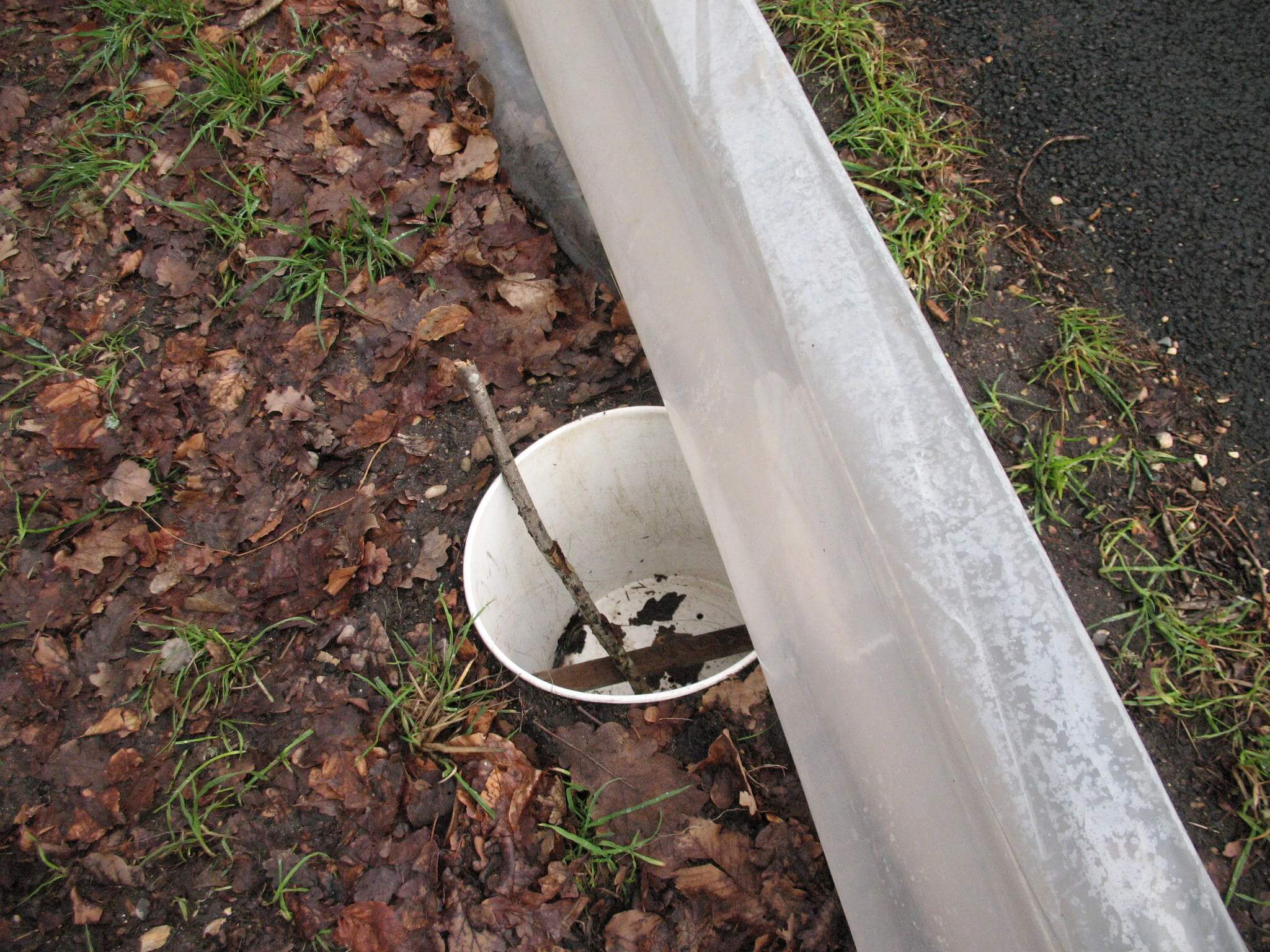RATIONALE. Amphibian passages
The appropriate size of an amphibian underpass is determined by its length, which depends on the width of the road (Schmidt & Zumbach, 2008). Although some studies have reported amphibians using tunnels as narrow as 0.20 m in diameter (Jochimsen et al., 2004; Lesbarrères et al., 2004; Bain, 2014), there is broad consensus that larger tunnels are more effective for amphibians, including juveniles, and can also be used by other species, such as some reptiles and small mammals (Hamer et al., 2015; Jarvis et al., 2019). Moreover, narrow structures could be rapidly blocked with silt, leaves or other materials. Other aspects, like temperature and humidity compared to the outside, substrate, and illumination inside the underpass must also be taken into consideration (Wind et al., 2014; Hamer et al., 2015).
Some examples of structures that provide suitable conditions for water, light and humidity are 50 cm width climate tunnels with grids at the top. They have proven to be effective for different species mostly in northern Europe and North America (Hill et al., 2018; Jarvis et al., 2019; Helldin & Petrovan, 2019; Denneboom et al., 2021). These tunnels were used by frogs, toads and newts, but the tunnels’ role in viable population connectivity is unproven. Schmidt et al. (2020) suggests such widths are insufficient to prevent long term decline in toad populations and Ottburg & van der Grift (2019) reported that a density of tunnels higher than 2.2/km is needed to maintain connectivity, especially in long migration corridors. Amphibian passages should be built closely together, with a maximum distance between them of 60 m, to improve the chances that animals can find them. Open grid tunnels can be effective in maintaining connectivity across small roads, in particular for newt species, but can suffer significant pollution from water that drains into the tunnel or from salt in mountain and cold-weather roads from the road surface (White et al., 2017) and should ideally be cleaned by flushing at regular intervals.
General description and targets
Amphibian passages (traditionally called amphibian tunnels) are a system of underpasses specifically designed to allow the movement of frogs, toads, newts and other species of amphibians. Passages are linked to opaque smooth guiding fences, to prevent animals from accessing the road and funnel them to the entrance. Multiple underpasses are placed in close proximity to each other (Figure 5.5.51). Temporary installations are also applied in some conditions, consisting of temporary fences and buckets to prevent amphibians from accessing the transport infrastructure. Amphibians caught in these buckets are taken to the other side of the transport infrastructure and released. Both types are described in this section.
The vast majority of amphibians have a bi-phasic biological cycle characterized by an aquatic phase (eggs and larvae) and a terrestrial phase (juveniles and adults). Generally once the juveniles leave the aquatic environment, they often do not return to the water until the time comes to reproduce, except those species which are more aquatic or during warm and dry weather.
Each year, the adults migrate to and from their terrestrial habitats and the aquatic breeding grounds and juveniles leave the aquatic habitats post metamorphosis. In addition to these reproduction migratory movements, other movements take place in searching for food, going to seasonal territories or dispersing to new territories. These different purposes bring different targets for mitigation measures when trying to maintain populations. Preserving as close to 100% of the migrant individuals during breeding is desirable, while a much smaller percentage of the total population could be sufficient during dispersal depending on the context.
The best placement of amphibian tunnels requires monitoring and study periods should be adapted according to the species, which varies significantly between regions and species. Frog and toad species mainly need to cross transport infrastructure in late winter and spring, while newt species do so in autumn.
When transport infrastructure intersects migration routes in particular, road mortality and habitat fragmentation can be substantial and thus specific risk minimization measures must be taken to ensure the safe crossing for breeding adults and dispersing juveniles reducing mortality risks. Numerous other negative impacts on populations include chemical pollution (e.g. from de-icing substances) noise and light pollution that should also be reduced wherever possible.
On existing roads or to isolate infrastructure works areas from migrating amphibians, the absence of crossing structures may be compensated for by the installation of temporary amphibian collection systems (typically by erecting temporary fences and pitfall bucket systems) during significant migratory movements. Due to the resulting personnel requirements to implement and monitor such systems, the creation of a permanent crossing will be more cost effective even if expensive to build and with ongoing maintenance. There are further arguments which offset the costs related to permanent passages, in that temporary measures may fail to predict the movement of juvenile amphibians, leaving them exposed to high mortality. Increasing traffic density also renders temporary measures insufficient to protect a population. Effective permanent amphibian passages, as well as other types of wildlife passages suitable for amphibians, e.g. viaducts, protect all migrators, including juveniles.
Permanent installations
These devices specifically designed for amphibians maintain or restore the functionality and safety of migratory movements on new or existing infrastructure. These passages are generally installed in areas of high amphibian mortality risk and are in addition to other wildlife passages such as adapted culverts, that could also ensure amphibian crossing together with other species.
Amphibian passages should also be placed at strategic sections where the infrastructure is intersecting a migration corridor guaranteeing overall population connectivity and dispersal. This is especially important for certain particularly endangered species (e.g.: newts) which show more diffuse migration areas, even if hotspots of high mortality are not observed on the infrastructure.
These specialized passages are made up of two components:
- A guiding structure providing a barrier to prevent amphibians from accessing the road and guide them towards safe crossing devices.
- A crossing structure comprising a series of tunnels under a road or a railway through which amphibians cross safely to the other side.
Guiding structures
- Metal, plastic or concrete are common materials used in different types of guiding fences, which should be durable (at least 10 years) and smooth to make it difficult for amphibians to climb. Concrete fences tend to be more durable and could provide the most effective option at long term.
- Guiding fencing should be buried or well anchored at the base, leaving no holes, and perpendicular to the ground. A rounded fence shape does not provide adequate guiding.
- The ends of the fences should be U-shaped to direct amphibians away from the road when they reach the ends of the barrier (Figure 5.5.52).
- The height should be at least 40 cm over ground, even 60 cm if some target species are living in the area (e.g.: agile frog Rana dalmatina).
- The top part of the barrier must form a flap to prevent animals climbing over.
- A movement surface free from vegetation is recommended right beside the barrier and vegetation adjacent to the movement corridor should provide cover.
- The guiding structures should be placed as close to the road as possible to minimise the length of the crossing tunnel. A safety barrier prevents vehicles from becoming stuck in the guiding structures.
- Corners and edges should be avoided especially where the guiding structure joins the entrance to the tunnel.
- Fences should be placed to reduce the risk of damage during mechanical verge vegetation cutting (Figure 5.5.53).
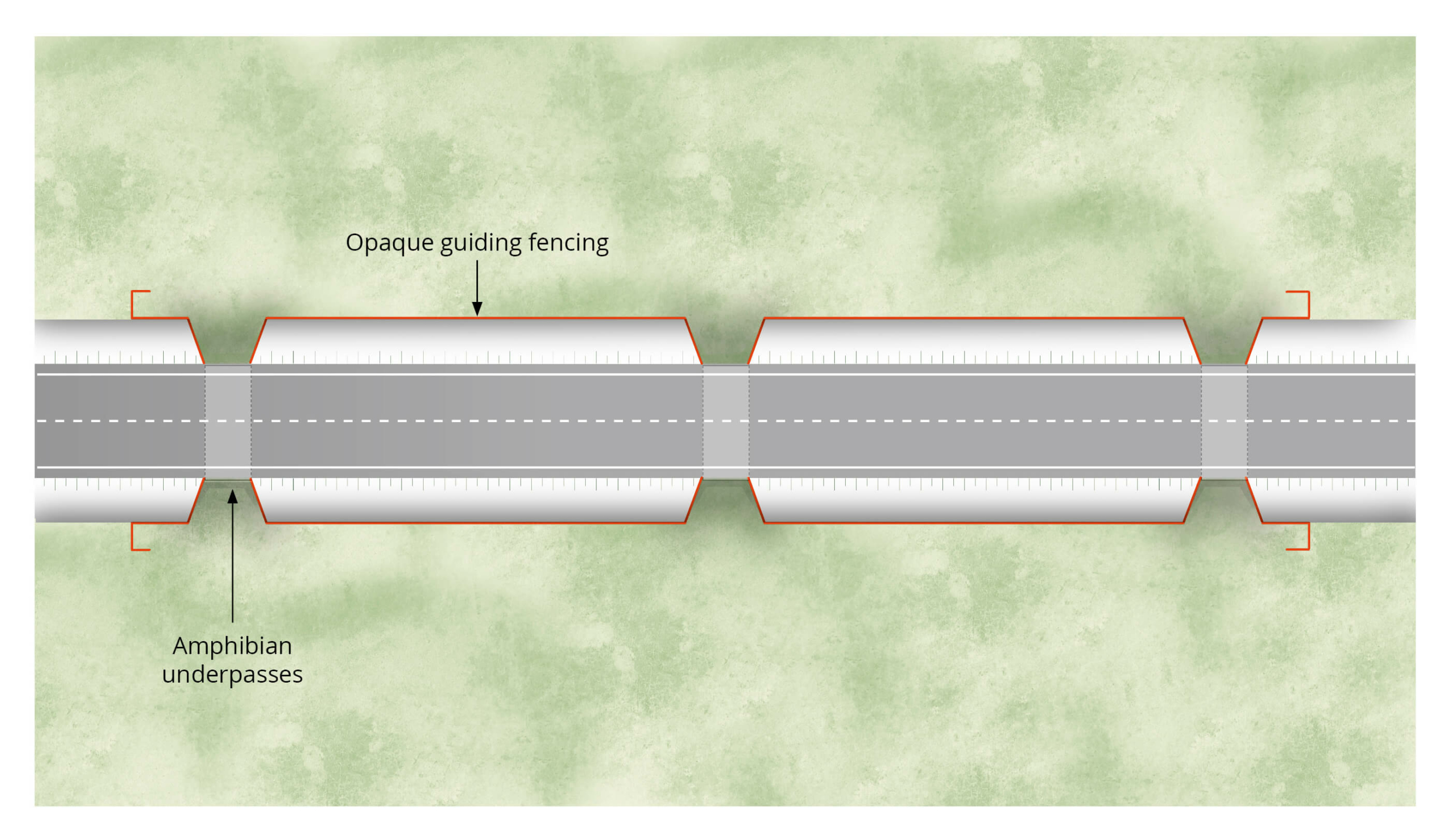
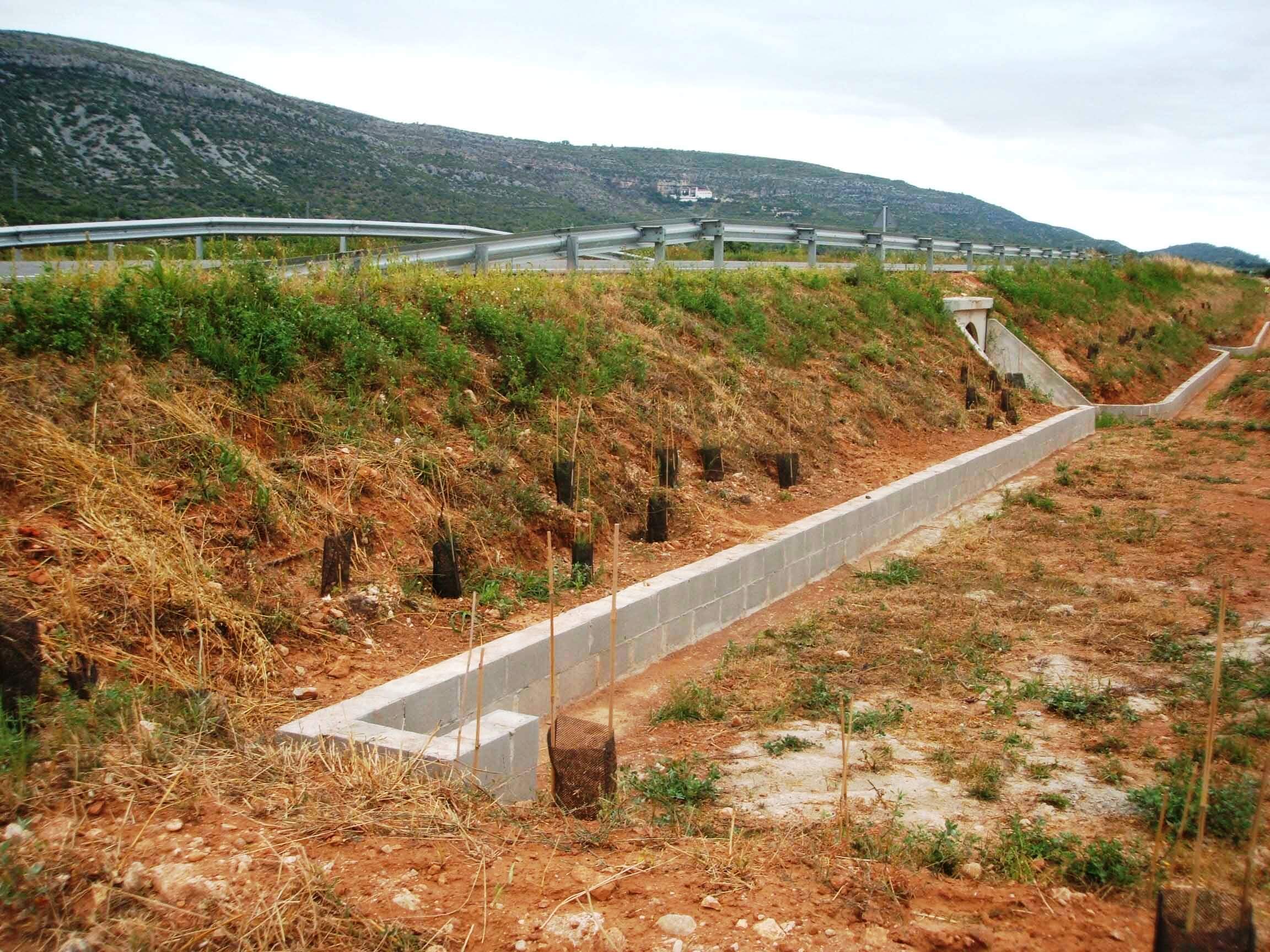
Amphibian underpasses
- Distances between tunnels must be as short as possible to maximise the chance for amphibians to find a tunnel entrance, to a maximum of 60 m.
- Width of the structure must be as large as possible, with a minimum of 1 m in underpasses less than 20 m long. Ideally they must be as short and as wide as possible. Width should be adapted to the length of the tunnel. The dimensions recommended in Table 5.5 have been successfully tested and guarantee that the structures are also suitable for small mammals and some reptiles and maintenance is feasible. A smaller width (40-50 cm minimum) may be the best achievable when providing defragmentation measures on existing infrastructure where hotspots of amphibian mortality are detected. These passages can be expected to be used by amphibians, but may not be suitable for all species and could pose maintenance difficulties.
- allowing the animals to move in both directions (also known as ‘two-way systems’) are recommended (Figure 5.5.54) allowing free movement of amphibians if there is an appropriate width (see Table 5.3 and Table 5.5). A double-pipe system (one-way tunnels), with separate pipes for each direction of crossing is not recommended. There is little evidence it is effective and is more complicated to build and maintain. This type is not suitable for small mammals and may even trap amphibians if not properly installed and maintained.
- Crossing structures must be rectangular or dome-shape. Circular structures are not recommended because some species attempt to climb the tunnel walls which then takes a long time to cross or could even trap them inside. Tunnels with rectangular cross-sections are also recommended because of the larger base compared to pipes of similar heights. It is also easier to fix guiding structures to the vertical tunnel entrance.
- Structures without concrete on the base are preferable because they maintain contact with the natural, moist surface and allow soil to be added during installation.
- Concrete passage construction is preferable to steel, plastic or other materials because it is more durable and easier to maintain.
- Amphibians are susceptible to desiccation, especially young animals and this is particularly relevant because, in Europe, juveniles normally cross roads in late summer. Protecting the movement of these juveniles is vital to ensure population survival, so longer, drier tunnels are not as effective as those in combination with an aquatic element, such as a drainage channel or carrying a stream.
- Water should drain easily from the tunnels. Standing water in the tunnel is generally not recommended even if some species (e.g. salamanders and newts) are reported to use completely flooded passages.
Table 5.5 – Minimum size requirements according to length for each tunnel in an amphibian underpass system for new infrastructure. Circular tunnels are not recommended. Tunnels more than 40 m long are demonstrated to be less effective and should be avoided; in these cases other types of wildlife passages such as multiuse underpasses, viaducts or landscape bridges could be adapted to amphibian use.
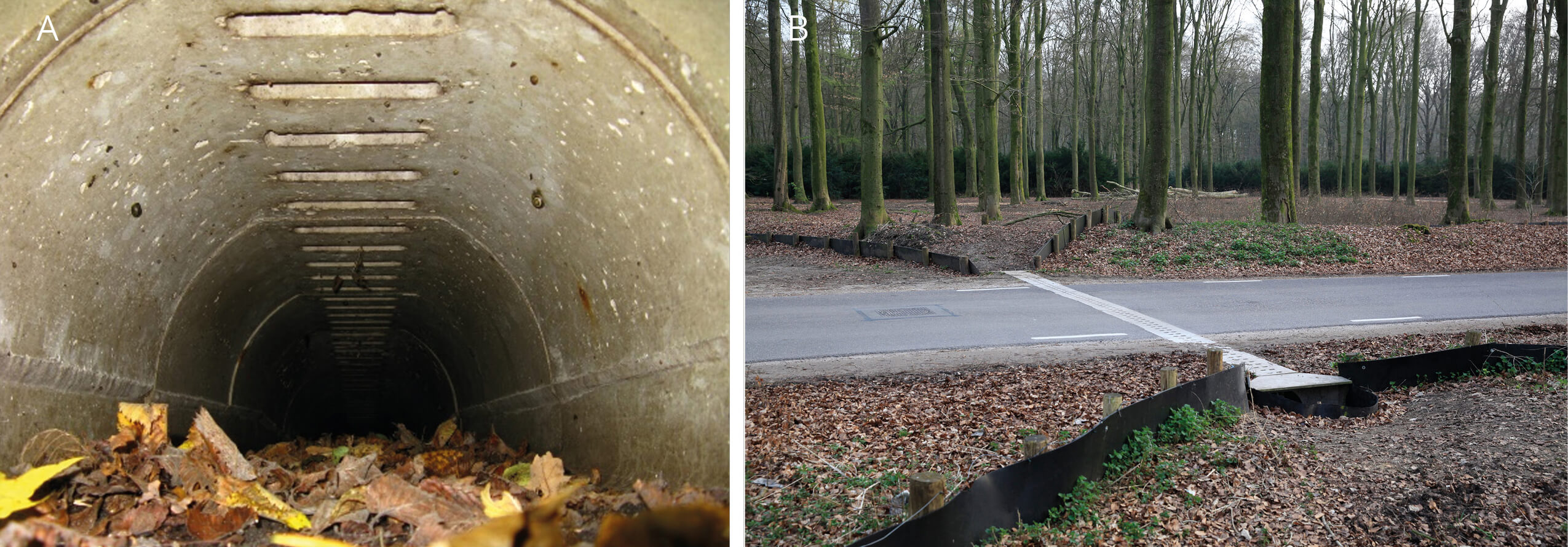
Other types of wildlife passages suitable for amphibians
- Other types of wildlife passages such as viaducts, adapted culverts, landscape bridges and wildlife overpasses are recommended instead of amphibian tunnels where the passage would be more than 40 m or where necessary humid conditions cannot be guaranteed. In all cases the installation of appropriate guiding amphibian fencing is recommended.
- Viaducts and adapted culverts that connect aquatic habitats such as rivers and wetlands could be particularly useful for amphibian crossing. Small culverts which are permanently flooded are not suitable.
- Landscape bridges and wildlife overpasses could also be used if they guarantee appropriate conditions (particularly humidity) for amphibians. Maintenance of small ponds at the entrances of the structures could be useful. This type of overpass is not suitable if located in dry areas where humidity of the soil is not guaranteed.
Provisions for amphibian on railway infrastructure
- To avoid that amphibians and other small vertebrates get trapped between the rails and die by dehydration, appropriate fencing guiding the animals to amphibian passages must be provided. This is particularly important when railway is crossing areas where breeding sites are located. Mortality in railways seems to also depend on physical features of the amphibians, such as body size and limb length, and may be associated with the agility of the species Common toad is more likely to become trapped while other species of small size may be less vulnerable because they cannot cross the rail track.
- Creating trenches under the rail lines complimented with rejection devices (Figure 5.5.55), may also offer safe crossing for amphibians in an easy and cheaper way. While the effectiveness of these systems is still not established, the current recommendation is to install amphibian deflectors and trenches at a distance of least every 8 to 12 train sleepers. A final assessment of the functionality and application areas of these measures is still pending.
Temporary installations
Where a crossing passage cannot be provided or when undergoing construction, a migration corridor for amphibians can be protected to a certain extent by building a barrier to block access to the road and guide the amphibians to collection buckets dug into the ground (Figure 5.5.56). The animals are then transported and released by volunteers on the other side of the road on a daily basis.
On existing roads, the system is usually installed only where volunteers are available to check the installations at least once a day and preferably twice (morning and evening) or more. In the majority of cases, this solution is mainly applied to protect amphibians migrating towards breeding sites, unlike return migrations of adults and the dispersal of juveniles which are not targeted. Therefore, this measure can probably sufficiently maintain the population only if there is light to moderate traffic.
Buckets
- The buckets should be at least 30-40 cm deep.
- The bucket rim should be level with the ground.
- The recommended distance between the buckets is 10 to 15 m.
- During the peak migration period, buckets have to be checked frequently. The frequency depends on the number of animals present: at least one to three times per 24 hours and in areas with large numbers of amphibians, up to every half hour. If only one check can take place, it should be late at night or early in the morning.
- Care must be taken to prevent water from accumulating in the buckets and leading to the drowning of trapped animals. A perforation of the bottom of the bucket (3 mm holes) placed on a bed of pebbles to ensure filtration or emptying the bucket manually may be necessary.
- In some situation a broad bucket with straight walls is recommended to prevent newts, young frogs and toads or tree-frogs from climbing out
- At locations where mice and shrews could get trapped in the buckets, a thin stick placed inside it may help them climb out
- To avoid the risk of desiccation adding dead leaves and a damp sponge at the bottom of the bucket maintains a level of humidity.
Barriers
- Barriers should be used to guide amphibians to the buckets.
- The fence should be opaque and smooth. Wire mesh and particularly netting are not recommended because amphibians can climb over these (see Section 5.2.4 – Fencing and reinforcements for small vertebrates; Figure 5.2.15).
- No space should be left between the barriers and the buckets so amphibians won’t miss the buckets.
- Buckets should be placed at the ends of the fence.
- The minimum height of the fence should be 40 cm. In presence of more agile species (e.g. agile frog) the height should be at least 60 cm.
- There must be no gaps or holes between the substrate and the fence. The barrier must be extended into the ground (5-20 cm) or lowered to the ground and anchored with mounds of earth or sand. To prevent amphibians from climbing over, bending back the top of the barrier to form a curve and even angling the barrier back on the bucket side is recommended.
- Stakes to secure the barrier should be placed on the side away from where amphibians are moving.
